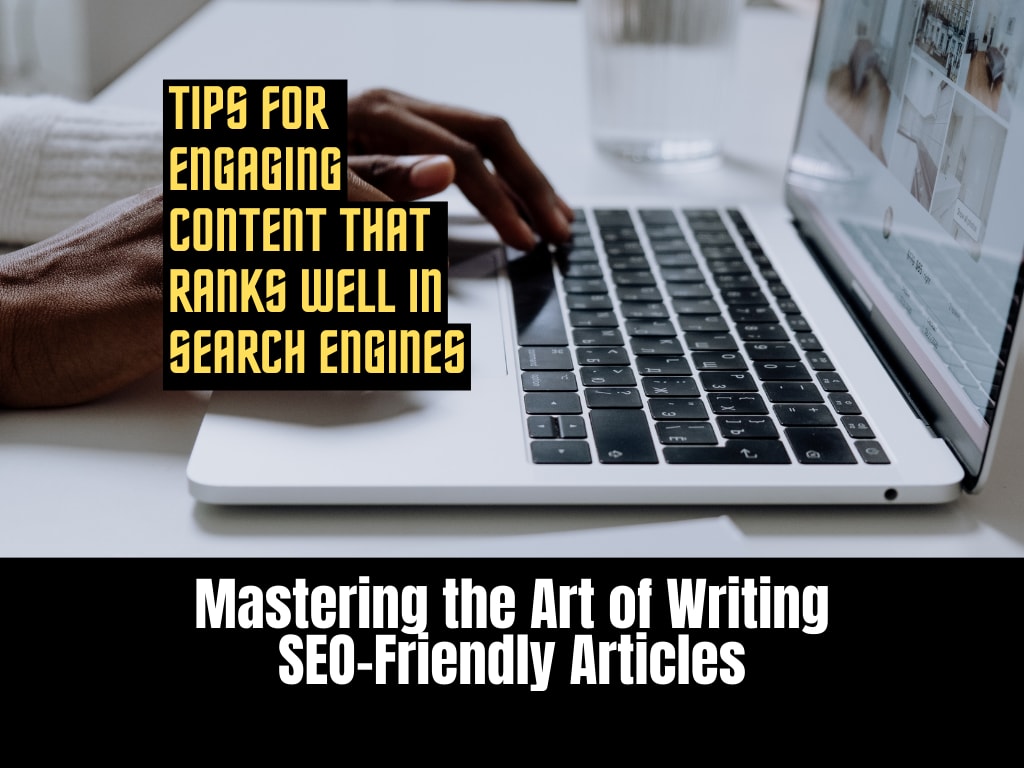Mastering the Art of Writing SEO-Friendly Articles
Tips for Engaging Content that Ranks Well in Search Engines

As a content creator, one of the most critical aspects of your job is writing articles that rank well in search engines. The higher your articles rank, the more traffic your website receives, and the more opportunities you have to engage with your audience. However, writing good, SEO-friendly articles is not always an easy task. It takes a bit of practice, but it’s worth it. Here are some tips to help you create articles that are both interesting to read and optimized for search engines.
Choose a topic that people are searching for

When deciding on a topic, it’s essential to keep in mind what people are searching for. You can use keyword research tools to find out what phrases people are using to search for information on your topic. This will help you create content that matches search intent, which is crucial for ranking well in search engines.
By understanding what people are searching for, you can tailor your content to provide the answers they need. You’ll be able to include the right keywords and topics that match their interests and queries. This will make your content more relevant and valuable to your target audience, which will help your rankings in the long run.
Write a compelling headline

Your headline is the first thing readers see, and it’s essential to grab their attention. A good headline is not only attention-grabbing but also includes your target keyword. Keep in mind that your headline should accurately reflect the content of your article.
When writing your headline, try to think about what would make someone click through to read more. What question or problem does your content address? How can you frame it in a way that is interesting and relevant to your target audience? By creating a compelling headline, you’ll be able to attract more readers and increase your traffic.
Write for your audience
Your content should be tailored to suit the needs and interests of your intended audience. Consider the type of language, tone, and style that would appeal to them. Write in a conversational style, using short paragraphs and sentences. This enhances the readability and comprehension of your content.
Your readers should be your priority when creating content. You should understand their needs and preferences so that you can craft your articles to meet those needs. This will help you engage with your audience and build a loyal following. By keeping your audience in mind when writing, you’ll be able to create content that resonates with them and keeps them coming back for more.
Use subheadings
Subheadings help break up long blocks of text, making your content more readable. They also provide structure and organization to your article. When writing your subheadings, make sure they are clear, concise, and contain your target keywords.
Subheadings are an excellent way to break up your content and make it easier for your readers to digest. They also help you organize your thoughts and keep your writing focused. By using subheadings, you’ll be able to make your content more appealing to your readers and optimize it for search engines at the same time.
Use internal and external links
Internal links help keep readers on your website, and external links help establish your content as a reliable source of information. Make sure your links are relevant to your content and add value to your readers.
Links are a great way to provide additional information and context to your readers. By including relevant links in your content, you’ll be able to add value to your readers and establish your website as a reliable source of information. You’ll also be able to keep your readers engaged and on your site for longer, which can help your rankings.
Use images and videos
Images and videos are a great way to break up text and make your content more engaging. They also provide additional information that can help your readers understand your topic better. Make sure to optimize your images for search engines by using descriptive file names, alt tags, and captions that contain your target keywords.
Visuals are an excellent way to keep your readers engaged and interested in your content. They also help you convey information that might be difficult to explain in words. By using images and videos, you’ll be able to create a more immersive experience for your readers and make your content more shareable on social media.
Optimize your meta description and tags
Your meta description and tags are essential for ranking well in search engines. Your meta description is a short summary of your article that appears in search results, while your tags provide additional information about your content. Make sure to include your target keyword in both your meta description and tags.
Meta descriptions and tags are critical for both search engines and readers. Your meta description should be concise and informative, providing readers with an idea of what your content is about. Your tags should be relevant to your topic and contain your target keywords. By optimizing your meta description and tags, you’ll be able to improve your search engine rankings and attract more readers.
Edit and proofread your content
Editing and proofreading are essential for creating high-quality content. Your content should be free of errors and typos, and your writing should be clear and concise. Make sure to read your content out loud and have someone else review it before publishing.
Editing and proofreading are critical for creating content that is both readable and informative. By taking the time to review and refine your writing, you’ll be able to produce articles that are of the highest quality. This will help you establish yourself as a reliable source of information and improve your search engine rankings.
In conclusion, writing good, SEO-friendly articles requires a bit of practice and attention to detail. By choosing a relevant topic, writing a compelling headline, and creating content that is aimed at your target audience, you’ll be able to create articles that rank well in search engines and engage your readers. By using subheadings, links, images, and videos, you’ll be able to make your content more readable and engaging. Finally, by optimizing your meta description and tags and editing and proofreading your content, you’ll be able to create high-quality articles that establish your website as a reliable source of information.
About the Creator
KEVIN FRENCH
I am a financial expert and author, helping others achieve financial freedom through practical and psychological strategies. I have helped thousands of people improve their financial literacy and reach their goals.






Comments (1)
Choosing a topic based on keyword research is a smart strategy to ensure your content matches search intent. It's essential to provide the answers people are looking for by including the right keywords and topics that align with their interests and queries. Crafting a compelling headline that incorporates your target keyword is key to grabbing readers' attention. The headline should accurately reflect the content and address a question or problem that resonates with your audience. This approach will attract more readers and increase traffic to your website. Writing content tailored to your audience's needs and preferences is vital. By understanding their preferences and using a conversational style with short paragraphs and sentences, you enhance the readability and comprehension of your articles. Prioritizing your readers will help you engage with them and build a loyal following. Using subheadings breaks up lengthy text, improves readability, and adds structure to your articles. Clear and concise subheadings that contain target keywords are effective for organizing thoughts and making content appealing to readers while optimizing it for search engines. Incorporating internal and external links in your articles provides value to readers. Internal links keep readers on your website, while external links establish your content as a reliable source of information. Ensuring relevance and value in your links enhances readers' experience, engagement, and your website's rankings. Integrating images and videos within your content makes it more engaging and informative. Visuals help convey complex information and break up text. Optimizing images with descriptive file names, alt tags, and captions containing target keywords makes them searchable and shareable on social media. Optimizing your meta description and tags is essential for search engine rankings. A concise and informative meta description gives readers an idea of your article's content, while relevant tags improve visibility. Including your target keyword in both helps attract more readers and improve search engine rankings. Lastly, editing and proofreading your content before publishing is crucial for maintaining high quality. Error-free, clear, and concise writing establishes you as a reliable source of information and improves search engine rankings. Reviewing and refining your articles ensure they meet the highest standards. Overall, these tips provide valuable guidance for creating SEO-friendly articles that engage readers and rank well in search engines. Incorporating them into your writing process will undoubtedly enhance your content creation skills. Keep up the great work!